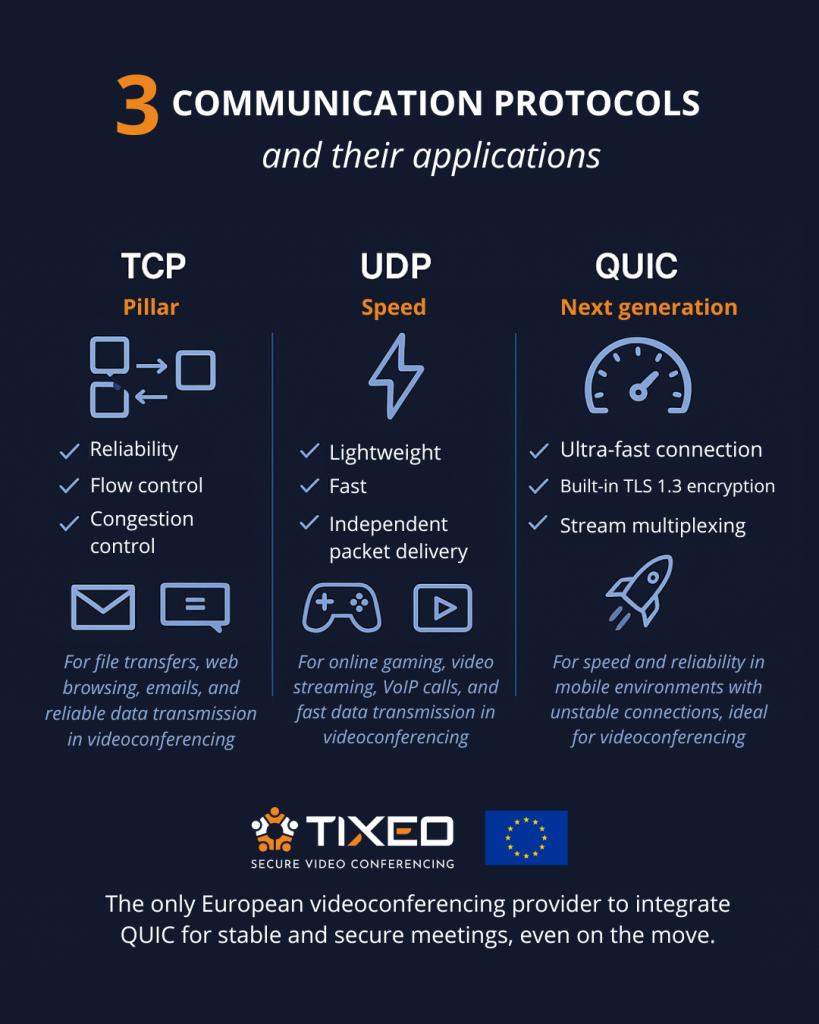To transmit real-time audio and video streams, videoconferencing solutions must carefully select their communication protocols. The objectives are clear: minimise latency, ensure smooth interactions, and deliver a high-quality user experience. Let’s explore the key characteristics of the main communication protocols and their specific applications in secure videoconferencing.
Definition and role of communication protocols
In computer networks and telecommunications, communication protocols define how data is formatted, transmitted, and received. In other words, they serve as a common language, enabling different systems to communicate effectively despite their distinct architectures.
These protocols play a crucial role in almost every online activity: from simple web browsing to streaming content, videoconferencing, and online gaming. The quality of the user experience—loading speed, system reliability, or communication security—largely depends on the efficiency of the chosen protocol.
To better understand the differences between protocols, it is worth recalling that network communication is divided into seven layers according to the OSI (Open Systems Interconnection) model. Each layer has specific functions and interacts with the adjacent layers to ensure seamless data transfer between systems (source: Data protection).
TCP : the historical pillar of Internet communication
The Transmission Control Protocol (TCP) is part of the Internet protocol suite (TCP/IP), the very foundation of Internet communications.
Three key characteristics:
- Reliability: TCP ensures that all data packets arrive at their destination in the correct order through an acknowledgement system and retransmission of lost packets.
- Flow control: it regulates the amount of data sent to prevent overwhelming the receiver.
- Congestion control: it dynamically adjusts the transmission rate according to network conditions.
These mechanisms make TCP the ideal choice for applications requiring accurate and complete data transmission (e.g. file transfer, web browsing, emails). In videoconferencing, TCP ensures smooth transmission while minimising losses and handling network fluctuations.
However, TCP’s verification and retransmission processes can introduce latency, especially on unstable networks.
UDP: speed above all else
The User Datagram Protocol (UDP) is a lighter alternative to TCP. It prioritises speed over reliability and operates as a connectionless protocol.
Unlike TCP, it does not establish a prior session or check whether packets have been received. It follows a so-called “fire and forget” model: data is sent to its destination without waiting for confirmation of receipt.
Three key characteristics:
- Lightweight: UDP does not verify whether data arrives correctly or needs to be resent, reducing network overhead.
- Fast: with no connection-establishment or data-verification processes, information is transmitted more quickly with minimal latency.
- Packet independence: each packet (or datagram) is sent separately, with no connection to others, simplifying operation.
Thanks to these characteristics, UDP is ideal for applications where speed is more important than reliability. This includes online gaming, video streaming, and voice calls over the Internet.
During a video call, for instance, it is better to momentarily lose a few pixels than to have the entire image freeze while waiting for lost packets to be retransmitted. For this reason, videoconferencing applications often rely on UDP, as real-time transmission fluidity outweighs perfect data accuracy.
QUIC : the next-generation communication protocol
QUIC (Quick UDP Internet Connections) represents a major leap forward in network communications. It ingeniously combines the reliability of TCP with the speed of UDP.
Specifically, QUIC uses UDP as the underlying transport mechanism to transfer packets between client and server while implementing many features traditionally associated with TCP—and addressing some of its limitations.
Three key characteristics:
- Ultra-fast connection: QUIC establishes a connection in a single round trip between client and server, significantly reducing connection time compared to TCP.
- Built-in security: QUIC integrates TLS 1.3 encryption directly, ensuring secure connections from the outset without additional steps.
- Smooth transmission: QUIC allows multiple data streams to be sent simultaneously over a single connection, so an issue in one stream does not block the others (unlike TCP).
QUIC is also gaining recognition for its improved handling of network changes, especially for mobile devices frequently switching connections. For videoconferencing, this network adaptability is crucial in situations involving mobility and travel.
For several years, Tixeo has been the only European vendor to integrate QUIC into its secure videoconferencing solution, maximising performance and stability regardless of network quality.

In summary, within a videoconferencing solution, multiple data streams transit simultaneously: audio, video, sometimes text, and screen sharing. Communication protocols are therefore essential to ensure interoperability between systems, enable real-time data transmission, and guarantee Quality of Service (QoS). Without them, videoconferencing would be far too unstable—if not entirely unfeasible.
Other Protocols Specific to Videoconferencing
Beyond TCP, UDP, and QUIC, videoconferencing solutions also rely on other specialised protocols:
- H.323 Protocol: one of the first standards for multimedia communication over IP. It functions as an integrated system for signalling, transport, and call control, still used in many infrastructures, though increasingly replaced by more flexible solutions.
- WebRTC (Web Real-Time Communication): an open-source technology enabling real-time communication directly in web browsers without plugins.
- SIP (Session Initiation Protocol): widely used for VoIP communications, it establishes and terminates multimedia sessions and is also used for instant messaging services.
- RTP and RTCP Protocols: the Real-time Transport Protocol (RTP) handles real-time multimedia data transmission, while RTCP (Real-time Transport Control Protocol) monitors quality, tracking packet loss and latency.
- RTMP (Real-Time Messaging Protocol): initially developed for Flash video streaming, still present in some videoconferencing solutions.
These protocols typically rely on UDP for media transport, but the rise of QUIC is gradually reshaping this paradigm, offering both low latency and improved reliability.

Video codecs and their interaction with protocols
A video codec compresses video files for storage and transmission and decompresses them for display.
While codecs determine the amount of data to be transmitted, protocols govern the method of delivery. A high-efficiency codec reduces network load, while a well-suited protocol ensures optimal delivery of the compressed data.
Modern codecs integrate advanced features such as adaptive encoding, dynamically adjusting compression levels based on network conditions and the underlying protocol capabilities—a decisive factor for videoconferencing quality.
Comparison: which protocol for which use case?
Choosing the right protocol depends on the organisation’s context: user volume, mobility, security requirements, hardware compatibility, etc.
For enterprises integrating videoconferencing with telephony systems, SIP is recommended. For closed environments requiring compatibility with legacy equipment, H.323 remains relevant. Finally, for organisations with mobile or globally distributed teams, QUIC offers the best performance.
In summary, TCP is best for:
- Applications demanding reliable transmission (file transfer, emails)
- Systems where data integrity outweighs speed
- Stable networks with high-quality Internet connections
UDP is preferable for:
- Real-time applications where low latency is critical
- Scenarios where occasional data loss is acceptable
- Systems needing minimal network overhead
QUIC excels for:
- Modern web applications requiring both speed and reliability
- Mobile environments with unstable connections
- Services needing integrated security and optimal performance
- Multimedia applications such as videoconferencing or streaming
As digital communications evolve, understanding protocols becomes essential for users prioritising performance and security.
While TCP and UDP remain widely used in today’s videoconferencing solutions, QUIC clearly represents the future, offering the ideal balance between user experience quality and transmission efficiency.
FAQ on the communication protocols
What is a communication protocol?
A communication protocol is a common language, a set of rules and conventions, that enables two or more devices to exchange data. In videoconferencing, these protocols ensure smooth, reliable, and secure real-time transmission between participants.
What types of protocols exist?
Protocols vary according to use:
- Network protocols (TCP, UDP, QUIC)
- Layer protocols (transport, session, application)
- Industrial protocols (e.g. Modbus TCP) for communication between controllers and sensors
Each protocol defines procedures such as acknowledgements (TCP), packet segmentation (UDP), or session resumption (QUIC) to ensure stable and predictable communication.
How does a communication protocol work?
The operation of a communication protocol relies on strict rules for data transmission and reception. Each protocol defines specific control procedures, such as acknowledgements (TCP), packet segmentation (UDP), or connection resumption (QUIC). These mechanisms ensure stable and predictable communication between devices.
Why are protocols important?
They ensure effective, reliable, and secure communication, enabling interoperability, error handling, and dependable data transfer. Without them, digital communication—whether videoconferencing, IoT, or industrial automation—would be impossible.
How to implement a protocol?
Implementing a communication protocol requires configuration within the network, the establishment of connections, and sometimes the addition of gateways for interoperability. Each protocol has its own implementation procedure, such as port declarations for RTP or certificate management for SIP.
Which protocols are used in videoconferencing?
Videoconferencing primarily relies on network and session protocols such as H.323, SIP, TCP, and UDP. These protocols establish, manage, and secure real-time audio, video, and data communications while ensuring interoperability across different systems. They also work in conjunction with video and audio codecs to ensure efficient, high-quality transmission.
Tixeo remains the only secure videoconferencing solution to integrate the QUIC layer, enabling greater adaptability to varying network conditions.
To enhance security in videoconferencing communications, additional security protocols such as TLS (Transport Layer Security) are often deployed. TLS provides encryption of data in transit, server authentication, and assurance of data integrity.With Tixeo, link encryption is performed using TLS, while end-to-end encryption (from client to client) of audio, video, and data streams is achieved with AES 256 (Advanced Encryption Standard 256).
What about industrial and IoT communications?
In industry, protocols like Modbus TCP, Profinet, or EtherCAT connect controllers, sensors, and control systems under strict real-time and reliability constraints.
IoT environments rely on protocols like Bluetooth, ZigBee, MQTT, or CoAP for low-power, large-scale wireless communications between sensors, actuators, and cloud platforms.

